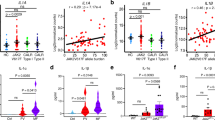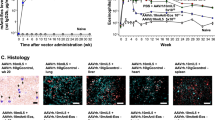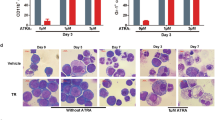Abstract
All-trans retinoic acid (ATRA) induces complete remission in patients with acute promyelocytic leukemia (APL). However, ATRA sometimes causes retinoic acid syndrome (RAS) characterized by respiratory distress, pleural effusions, fever and weight gain. To investigate the pathophysiology of RAS, we generated an animal model by injecting an APL cell line, NB4, into immunodeficient mice. When NOD/scid mice were injected intravenously with fully differentiated NB4 cells (1 × 107) and then given a daily administration of ATRA, three of 12 mice died of pulmonary edema within 14 days. Pathologically, dilated lung capillary vessels and alveolar effusions were observed. After the injection, NB4 cells were detected in the lung within 2 days and in the pleural effusion later on. The gene expression levels of CXC chemokines (MIP-2 and KC) and ICAM-1 were increased in the lung and heart by the ATRA administration. In immunohistochemical analyses, MIP-2 was clearly detected in alveolar macrophages of the lung in mice with RAS. Dexamethasone treatment prevented the development of RAS and decreased the CXC chemokine mRNA expression in the lung. These findings suggested that the activation of adhesion molecules for leukocytes and expression of CXC chemokines in the lung are closely involved in triggering RAS.
This is a preview of subscription content, access via your institution
Access options
Subscribe to this journal
Receive 12 print issues and online access
$259.00 per year
only $21.58 per issue
Buy this article
- Purchase on Springer Link
- Instant access to full article PDF
Prices may be subject to local taxes which are calculated during checkout








Similar content being viewed by others
References
Tallman MS, Andersen JW, Schiffer CA, Appelbaum FR, Feusner JH, Ogden A et al. All-trans-retinoic acid in acute promyelocytic leukemia. N Engl J Med 1997; 337: 1021–1028.
Kanamaru A, Takemoto Y, Tanimoto M, Murakami H, Asou N, the Japan Adult Leukemia Study Group et al. All-trans retinoic acid for the treatment of newly diagnosed acute promyelocytic leukemia. Blood 1995; 85: 1202–1206.
Warrell RP, De The H, Wang Z-Y, Degos L . Acute promyelocytic leukemia. N Engl J Med 1993; 329: 177–189.
Ferbeyre G . PML a target of translocations in APL is a regulator of cellular senescence. Leukemia 2002; 16: 1918–1926.
Frankel SR, Eardley A, Lauwers G, Weiss M, Warrell RP . The ‘retinoic acid syndrome’ in acute promyelocytic leukemia. Ann Intern Med 1992; 117: 292–296.
Tallman MS, Andersen JW, Schiffer CA, Appelbaum FR, Feusner JH, Ogden A et al. Clinical description of 44 patients with acute promyelocytic leukemia who developed the retinoic acid syndrome. Blood 2000; 95: 90–95.
De Botton S, Dombret H, Sanz M, San Miguel J, Caillot D, Zittoun R, the European APL Group et al. Incidence, clinical features, and outcome of all trans-retinoic acid syndrome in 413 cases of newly diagnosed acute promyelocytic leukemia. Blood 1998; 92: 2712–2718.
Camacho LH, Soignet SL, Chanel S, Ho R, Heller G, Scheinberg DA et al. Leukocytosis and the retinoic acid syndrome in patients with acute promyelocytic leukemia treated with arsenic trioxide. J Clin Oncol 2000; 18: 2620–2625.
Ware LB, Matthay MA . The acute respiratory distress syndrome. N Engl J Med 2000; 342: 1334–1349.
Fenaux P, Chomienne C, Degos L . All-trans retinoic acid and chemotherapy in the treatment of acute promyelocytic leukemia. Semin Hematol 2001; 38: 13–25.
Marchetti M, Falanga A, Giovanelli S, Oldani E, Barbui T . All-trans-retinoic acid increases adhesion to endothelium of the human promyelocytic leukaemia cell line NB4. Br J Haematol 1996; 93: 360–366.
Kitamura K, Kiyoi H, Yoshida H, Saito H, Ohno R, Naoe T . Mutant AF-2 domain of PML-RARα in retinoic acid-resistant NB4 cells: differentiation induced by RA is triggered directly through PML-RARα and its down-regulation in acute promyelocytic leukemia. Leukemia 1997; 11: 1950–1956.
Taraboletti G, Borsotti P, Chirivi RGS, Vergani V, Falanga A, Barbui T et al. Effect of all trans-retinoic acid (ATRA) on the adhesive and motility properties of acute promyelocytic leukemia cells. Int J Cancer 1997; 70: 72–77.
Seale J, Delva L, Renesto P, Balitrand N, Dombret H, Scrobohaci M-L et al. All-trans retinoic acid rapidly decreases cathepsin G synthesis and mRNA expression in acute promyelocytic leukemia. Leukemia 1996; 10: 95–101.
Zang C, Liu H, Ries C, Ismair MG, Petrides PE . Enhanced migration of the acute promyelocytic leukemia cell line NB4 under in vitro conditions during short-term all-trans-retinoic acid treatment. J Cancer Res Clin Oncol 2000; 126: 33–40.
Devy L, Hollender P, Munaut C, Colige A, Garnotel R, Foidart J-M et al. Matrix and serine protease expression during leukemic cell differentiation induced by aclacinomycin and all-trans-retinoic acid. Biochem Pharmacol 2002; 63: 179–189.
Dubois C, Schlageter MH, de Gentile A, Balitrand N, Toubert ME, Krawice I et al. Modulation of IL-8, IL-1β, and G-CSF secretion by all-trans retinoic acid in acute promyelocytic leukemia. Leukemia 1994; 8: 1750–1757.
Behringer D, Schaufler J, Kresin V, Lubbert M, Lindemann A . Differentiation associated modulation of the cytokine and chemokine expression pattern in human myeloid cell lines. Luekemia Res 2001; 25: 141–149.
Hsu H-C, Tsai W-H, Chen P-G, Hsu M-L, Ho C-K, Wang S-Y . In vitro effect of granulocyte-colony stimulating factor and all-trans retinoic acid on the expression of inflammatory cytokines and adhesion molecules in acute promyelocytic leukemic cells. Eur J Haematol 1999; 63: 11–18.
Kosugi H, Ito M, Yamamoto Y, Towatari M, Ito M, Ueda R et al. In vivo effects of a histone deacetylase inhibitor, FK228, on human acute promyelocytic leukemia in NOD/Shi-scid/scid mice. Jpn J Cancer Res 2001; 92: 529–536.
Ito M, Hiramatsu H, Kobayashi K, Suzue K, Kawahata M, Hioki K et al. NOD/SCID/γcnull mouse: an excellent recipient mouse model for engraftment of human cells. Blood 2002; 100: 3175–3182.
Matzer SP, Baumann T, Lukacs NW, Rollinghoff M, Beuscher HU . Constitutive expression of macrophage-inflammatory protein 2 (MIP-2) mRNA in bone marrow gives rise to peripheral neutrophils with preformed MIP-2 protein. J Immunol 2001; 167: 4635–4643.
Zhang XW, Wang Y, Liu Q, Thorlacius H . Redundant function of macrophage inflammatory protein-2 and KC in tumor necrosis factor-α-induced extravasation of neutrophils in vivo. Eur J Pharmacol 2001; 427: 277–283.
Tsai WC, Strieter RM, Hehrad B, Newstead MW, Zeng X, Standiford TJ . CXC chemokine receptor CXCR2 is essential for protective innate host response in murine Pseudomonas aeruginosa Pneumonia. Infect Immun 2000; 68: 4289–4296.
Wuyts A, D'Haese AD, Cremers V, Menten P, Lenaerts J-P, De Loof A et al. NH2- and COOH-terminal truncations of murine granulocyte chemotactic protein-2 augment the in vitro and in vivo neutrophil chemotactic potency. J Immunol 1999; 163: 6155–6163.
Bozic CR, Kolakowski LF, Gerard NP, Garcia-Rodriguez C, von Uexkull-Guldenhand C, Conklyn MJ et al. Expression and biologic characterization of the murine chemokine KC. J Immunol 1995; 154: 6048–6057.
Smith JB, Herschman HR . Glucocorticoid-attenuated response gene encode intercellular mediators, including a new C-X-C chemokine. J Biol Chem 1995; 270: 16756–16765.
Harant H, de Martin R, Andrew PJ, Foglar E, Dittrich C, Lindley IJD . Synergistic activation of interleukin-8 gene transcription by all-trans-retinoic acid and tumor necrosis factor-α involves the transcription factor NF-κB. J Biol Chem 1996; 271: 26954–26961.
Chang MM-J, Harper R, Hyde DM, Wu R . A novel mechanism of retinoic acid-enhanced interleukin-8 gene expression in airway epithelium. Am J Respir Cell Mol Biol 2000; 22: 502–510.
Rollins BJ . Chemokines. Blood 1997; 90: 909–928.
Shibakura M, Niiya K, Kiguchi T, Shinagawa K, Ishimaru F, Ikeda K et al. Simultaneous induction of matrix metalloproteinase-9 and interleukin 8 by all-trans retinoic acid in human PL-21 and NB4 myeloid leukaemia cells. Br J Haematol 2002; 118: 419–425.
Walzog B, Weinmann P, Jeblonski F, Scharffetter-Kochanek R, Bommert R, Gaehtgens P . A role for β2 integrins (CD11/CD18) in the regulation of cytokine gene expression of polymorphonuclear neutrophils during the inflammatory response. FASEB J 1999; 13: 1855–1865.
Muller AM, Cronen C, Muller K-M, Kirkpatrick CJ . Heterogeneous expression of cell adhesion molecules by endothelial cells in ARDS. J Pathol 2002; 198: 270–275.
Zimmerman GA, Albertine KH, Carveth HJ, Gill EA, Grissom CK, Hoidal JR et al. Endothelial activation in ARDS. Chest 1999; 116: 18S–24S.
Di Noto R, Schiavone EM, Ferrara F, Manzo C, Pardo CL, Del Vecchio L . All-trans retinoic acid promotes a differential regulation of adhesion molecules on acute myeloid leukaemia blast cells. Br J Haematol 1994; 88: 247–255.
Di Noto R, Schiavone EM, Ferrara F, Manzo C, Lo Pardo C, Del Vecchio L . Expression and ATRA-driven modulation of adhesion molecules in acute promyelocytic leukemia. Leukemia 1994; 8: S71–S76.
Tallman MS . Retinoic acid syndrome: a problem of the past? Leukemia 2002; 16: 160–161.
Brown DC, Tsuji H, Larson RS . All-trans retinoic acid regulates adhension mechanism and transmigration of the acute promyelocytic leukaemia cell line NB-4 under physiologic flow. Br J Haematol 1999; 107: 86–98.
Mustjoki S, Alitalo R, Elonen E, Carpen O, Gahmberg CG, Vaheri A . Intercellular adhesion molecule-1 in extravasation of normal mononuclear and leukaemia cells. Br J Haematol 2001; 113: 989–1000.
McColl SR, Clark-Lewis I . Inhibition of murine neutrophil recruitment in vivo by CXC chemokine receptor antagonists. J Immunol 1999; 163: 2829–2835.
Li F, Gordon JR . IL-8(3–73) K11R is a high affinity agonist of the neutrophil CXCR1 and CXCR2. Biochem Biophys Res Commun 2001; 286: 595–600.
Hallahan DE, Virudachalam S . Intercellular adhension molecule 1 knockout abrogates radiation induced pulmonary inflammation. Proc Natl Acad Sci USA 1997; 94: 6432–6437.
Mukaida N, Matsumoto T, Yokoi K, Harada A, Matsushima K . Inhibition of neutrophil-mediated acute inflammatory injury by an antibody against interleukin-8 (IL-8). Inflamm Res 1998; 47: S151–S157.
Acknowledgements
This study was performed in cooperation with Research on the Human Genome, Tissue Engineering, and Food Biotechnology from the Ministry of Health and Welfare. We thank Ms Manami Kira, Ms Kyoko Aoyama and Mr Takashi Iwasaki for secretarial and technical assistance. This work was supported by Grants-in-Aid from the Ministry of Health and Welfare, and the Ministry of Education, Culture, Sports, Science and Technology.
Author information
Authors and Affiliations
Corresponding author
Rights and permissions
About this article
Cite this article
Ninomiya, M., Kiyoi, H., Ito, M. et al. Retinoic acid syndrome in NOD/scid mice induced by injecting an acute promyelocytic leukemia cell line. Leukemia 18, 442–448 (2004). https://doi.org/10.1038/sj.leu.2403284
Received:
Accepted:
Published:
Issue Date:
DOI: https://doi.org/10.1038/sj.leu.2403284
Keywords
This article is cited by
-
Differentiation therapy for myeloid malignancies: beyond cytotoxicity
Blood Cancer Journal (2021)
-
Interleukin-8 is not a predictive biomarker for the development of the acute promyelocytic leukemia differentiation syndrome
BMC Cancer (2020)
-
Current advances in humanized mouse models
Cellular & Molecular Immunology (2012)



